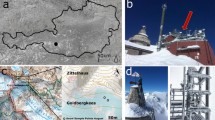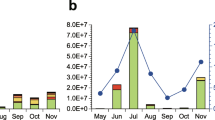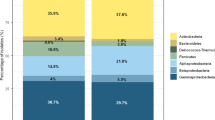Abstract
The atmosphere is host to an omnipresent bacterial community that may influence fundamental atmospheric processes such as cloud formation and precipitation onset. Knowledge of this bacterial community is scarce, particularly in air masses relevant to cloud formation. Using a light aircraft, we sampled above the atmospheric boundary layer—that is, at heights at which cloud condensation occurs—over coastal areas of Sweden and Denmark in summer 2009. Enumeration indicated total bacterial numbers of 4 × 101 to 1.8 × 103 m−3 air and colony-forming units of 0–6 bacteria m−3 air. 16S rRNA gene libraries constructed from samples collected above the Baltic Sea coast revealed a highly diverse bacterial community dominated by species belonging to the genera Sphingomonas and Pseudomonas. Bacterial species known to carry ice-nucleating proteins were found in several samples. Modeled back trajectories suggested the potential sources of the sampled bacteria to be diverse geographic regions, including both marine and terrestrial environments in the northern hemisphere. Several samples contained 16S rRNA genes from plant chloroplasts, confirming a terrestrial contribution to these samples. Interestingly, the airborne bacterial community displayed an apparent seasonal succession that we tentatively ascribe to in situ succession in the atmosphere.





Similar content being viewed by others
References
Altschul, S. F., Gish, W., Miller, W., Myers, E. W., & Lipman, D. J. (1990). Basic local alignment search tool. Journal of Molecular Biology, 215(3), 403–410.
Amato, P., Parazols, M., Sancelme, M., Laj, P., Mailhot, G., & Delort, A. M. (2007). Microorganisms isolated from the water phase of tropospheric clouds at the puy de dome: Major groups and growth abilities at low temperatures. FEMS Microbiology Ecology, 59(2), 242–254.
Ashelford, K. E., Chuzhanova, N. A., Fry, J. C., Jones, A. J., & Weightman, A. J. (2005). At least one in twenty 16 s rrna sequence records currently held in public repositories estimated to contain substantial anomalies. Applied and Environmental Microbiology, 12, 7724–7736.
Balkwill, D. L., Fredrickson, J. K., & Romine, M. F. (2006). Sphingomonas and related genera. In M. Dworkin, S. Falkow, E. Rosenberg, K. H. Schleifer, & E. Stackebrandt (Eds.), The prokaryotes: A handbook on the biology of bacteria (pp. 605–630). Singapore: Springer-Science.
Bauer, H., Kasper-Giebl, A., Löflund, M., Giebl, H., Hitzenberger, R., Zibuschka, F., et al. (2002). The contribution of bacteria and fungal spores to the organic carbon content of cloud water, precipitation and aerosols. Atmospheric Research, 64, 109–119.
Bowers, R. M., Lauber, C. L., Wiedinmyer, C., Hamady, M., Hallar, A. G., Fall, R., et al. (2009). Characterization of airborne microbial communities at a high-elevation site and their potential to act as atmospheric ice nuclei. Applied and Environmental Microbiology, 75, 5121–5130.
Brandt, J., Christensen, J. H., Frohn, L. M., & Berkowicz, R. (2001a). Operational air pollution forecasts from regional scale to urban street scale. Part 1: System description. Physics and Chemistry of the Earth Part B-Hydrology Oceans and Atmosphere, 26, 781–786.
Brandt, J., Christensen, J. H., Frohn, L. M., & Berkowicz, R. (2001b). Operational air pollution forecasts from regional scale to urban street scale. Part 2: Performance evaluation Physics and Chemistry of the Earth Part B-Hydrology Oceans and Atmosphere, 26, 825–830.
Brodie, E. L., DeSantis, T. Z., Parker, J. P. M., Zubietta, I. X., Piceno, Y. M., & Andersen, G. L. (2007). Urban aerosols harbor diverse and dynamic bacterial populations. Proceedings of the National Academy of Sciences, USA, 104(1), 299–304.
Cho, B. C., & Hwang, C. Y. (2011). Prokaryotic abundance and 16 s rrna gene sequences detected in marine aerosols on the east sea (korea). FEMS Microbiology Ecology, 76, 327–341.
Christner, B. C., Cai, R., Morris, C. E., McCarter, K. S., Foreman, C. M., Skidmore, M. L., et al. (2008a). Geographic, seasonal, and precipitation chemistry influence on the abundance and activity of biological ice nucleators in rain and snow. Proceedings of the National Academy of Sciences, USA, 105, 18854–18859.
Christner, B. C., Morris, C. E., Foreman, C. M., Cai, R., & Sands, D. C. (2008b). Ubiquity of biological ice nucleators in snowfall. Science, 319, 1214–1214.
Despres, V., Nowoisky, J., Klose, M., Conrad, R., Andreae, M. O., & Pöschl, U. (2007). Molecular genetics and diversity of primary biogenic aerosol particles in urban, rural, and high alpine air. Biogeosciences Discussions, 4, 349–384.
Di Giorgio, C., Krempff, A., Guiraud, H., Binder, P., Tiret, C., & Dumenil, G. (1996). Atmospheric pollution by airborne microorganisms in the city of marseilles. Atmospheric Environment, 30(1), 155–160.
Draxler, R. R., & Rolph, G. D. (2010). Hybrid single-particle lagrangian integrated trajectory (hysplit). Model access via noaa arl ready website: http://ready.Arl.Noaa.Gov/hysplit.Php.
Du, H. L., Jiao, N. Z., Hu, Y. H., & Zeng, Y. H. (2006). Diversity and distribution of pigmented heterotrophic bacteria in marine environments. FEMS Microbiology Ecology, 57, 92–105.
Fahlgren, C., Bratbak, G., Sandaa, R.-A., Thyrhaug, R., & Zweifel, U. L. (2011). Diversity of airborne bacteria in samples collected using different devices for aerosol collection. Aerobiologia, 27, 107–120.
Fahlgren, C., Hagström, Å., Nilsson, D., & Zweifel, U. L. (2010). Annual variations in the diversity, viability, and origin of airborne bacteria. Applied and Environmental Microbiology, 76, 3015–3025.
Fang, Z., Ouyang, Z., Zheng, H., Wang, X., & Hu, L. (2007). Culturable airborne bacteria in outdoor environments in beijing, china. Microbial Ecology, 54(3), 487–496.
Fierer, N., Liu, Z. Z., Rodriguez-Hernandez, M., Knight, R., Henn, M., & Hernandez, M. T. (2008). Short-term temporal variability in airborne bacterial and fungal populations. Applied and Environmental Microbiology, 74(1), 200–207.
Franc, G. D., & DeMott, P. J. (1998). Cloud activation characteristics of airborne erwinia carotovora cells. Journal of Applied Meteorology, 37, 1293–1300.
González, A. J., & Rodicio, R. (2007). Erwinia persicina causing chlorosis and necrotic spots in leaves and tendrils of pisum sativum in southeastern spain. Plant Disease, 91, 460.
Griffin, D. W., Kellogg, C. A., Garrison, V. H., Lisle, J. T., Borden, T. C., & Shinn, E. A. (2003). Atmospheric microbiology in the northern Caribbean during African dust events. Aerobiologia, 19, 143–157.
Hertel, O., Skjøth, C. A., Brandt, J., Christensen, J. H., Frohn, L. M., & Frydendall, J. (2003). Operational mapping of atmospheric nitrogen deposition to the Baltic Sea. Atmospheric Chemistry and Physics, 3, 2083–2099.
Hertel, O., Skjøth, C. A., & Fenger, J. (2009). Atmospheric physics, chapter 9. In J. Fenger, & J. C. Tjell (Eds.), Air pollution—From a local to a global perspective (p. 488). Polyteknisk forlag.
Hervàs, A., Camarero, L., Reche, I., & Casamayor, E. O. (2009). Viability and potential for immigration of airborne bacteria from Africa that reach high mountain lakes in Europe. Environmental Microbiology, 11, 1612–1623.
Hervàs, A., & Casamayor, E. O. (2009). High similarity between bacterioneuston and airborne bacterial community compositions in a high mountain lake area. FEMS Microbiology Ecology, 67, 219–228.
Holm, E., & Jensen, V. (1972). Aerobic chemoorganotrophic bacteria of a Danish beech forest. OIKOS, 23, 248–260.
Huber, T., Faulkner, G., & Hugenholtz, P. (2004). Bellerophon: A program to detect chimeric sequences in multiple sequence alignments. Bioinformatics, 20, 2317–2319.
Janjic, Z. I. (1990). The step-mountain coordinate: Physical package. Monthly Weather Review, 118, 1429–1443.
Janjic, Z. I. (1994). The step-mountain eta coordinate model: Further developments of the convection, viscous sublayer, and turbulence closure schemes. Monthly Weather Review, 122, 927–945.
Janssen, P. H. (2006). Identifying the dominant soil bacterial taxa in libraries of 16 s rrna and 16 s rrna genes. Applied and Environmental Microbiology, 72, 1719–1728.
Kaarakainen, P., Meklin, T., Rintala, H., Hyvärinen, A., Kärkkäinen, P., Vepsäläinen, A., et al. (2008). Seasonal variation in airborne microbial concentrations and diversity at landfill, urban and rural sites. CLEAN - Soil, Air, Water, 36(7), 556–563.
Kasprzyk, I., Myszkowska, D., Grewling, L., Stach, A., Sáikoparija, B., Skjøth, C. A., et al. (2011). The occurrence of ambrosia pollen in rzeszow, krakow and poznan poland: Investigation of trends and possible transport of ambrosia pollen from ukraine. International Journal of Biometeorology, 55, 633–644.
Kawahara, H. (2002). The structures and functions of ice crystal-controlling proteins from bacteria. Journal of Bioscience and Bioengineering, 94, 492–496.
Kellogg, C. A., & Griffin, D. W. (2006). Aerobiology and the global transport of desert dust. Trends in Ecology & Evolution, 21(11), 638–644.
Kobashigawa, Y., Nishimiya, Y., Miura, K., Ohgiya, S., Miura, A., & Tsuda, S. (2005). A part of ice nucleation protein exhibits the ice-building ability. FEBS Letters, 579, 1493–1497.
Lighthart, B. (1997). The ecology of bacteria in the alfresco atmosphere. FEMS Microbiology Ecology, 23, 263–274.
Lipson, D. A., & Schmidt, S. K. (2004). Seasonal changes in an alpine soil bacterial community in the Colorado Rocky mountains. Applied and Environmental Microbiology, 70, 2867–2879.
Ludwig, W., Strunk, O., Westram, R., Richer, L., Meier, H., Kumar, Y., et al. (2004). Arb: A software environment for sequence data. Nucleic Acids Research, 32, 1363–1371.
Mancinelli, R. L., & Shulls, W. A. (1978). Airborne bacteria in an urban-environment. Applied and Environmental Microbiology, 35(6), 1095–1101.
Maron, P. A., Lejon, D. P. H., Carvalho, E., Bizet, K., Lemanceau, P., Ranjard, L., et al. (2005). Assessing genetic structure and diversity of airborne bacterial communities by DNA fingerprinting and 16 s rdna clone library. Atmospheric Environment, 39(20), 3687–3695.
Martin, G. M., Johnson, D. W., Jonas, P. R., Rogers, D. P., Brooks, I. M., & Barlow, R. W. (1997). Effects of airmass type on the interaction between warm stratocumulus and underlying cumulus clouds in the marine boundary-layer. The Quarterly Journal of the Royal Meteorological Society, 123, 849–882.
Möhler, O., DeMott, P. J., Vali, G., & Levin, Z. (2007). Microbiology and atmospheric processes: The role of biological particles in cloud physics. Biogeosciences, 4, 1059–1071.
Muryoi, N., Matsukawa, K., Yamade, K., Kawahara, H., & Obata, H. (2003). Purification and properties of an ice-nucleating protein from an ice-nucleating bacterium, pantoea ananatis kuin-3. Journal of Bioscience and Bioengineering, 95, 157–163.
Nejad, P., Ramstedt, M., Granhall, U., Roos, S., & McIvor, I. (2006). Biochemical characterization and identification of ice-nucleation-active (ina) willow pathogens by means of biolog microplate, ina gene primers and pcr-based 16 s rrna-gene analyses. Journal of Plant Diseases and Protection, 113, 97–106.
Pinhassi, J., & Hagström, Å. (2000). Seasonal succession in marine bacterioplankton. Aquatic Microbial Ecology, 21, 245–256.
Pinhassi, J., Zweifel, U. L., & Hagström, Å. (1997). Dominant marine bacterioplankton species found among colony-forming bacteria. Applied and Environmental Microbiology, 63, 3359–3366.
Porter, K. G., & Feig, Y. S. (1980). The use of dapi for identifying and counting aquatic microflora. Limnology and Oceanography, 25(5), 943–948.
Pruppacher, H. R., & Klett, J. D. (1997). Microphysics of clouds and precipitation (2nd ed.). Dordrecht: Kluwer.
Reche, I., Ortega-Retuerta, E., Romera, O., Pulido-Villena, E., Morales-Baquero, R., & Casamayor, E. O. (2009). Effect of Saharan dust inputs on bacterial activity and community composition in mediterranean lakes and reservoirs. Limnology and Oceanography, 54, 869–879.
Sattler, B., Puxbaum, H., & Psenner, R. (2001). Bacterial growth in supercooled cloud droplets. Geophysical Research Letters, 28, 239–242.
Schlegel, H. G., & Jannasch, H. W. (1991). Prokaryotes and their habitats. In A. Balows, K. H. Schleifer, H. G. Truper, & M. Dworkin (Eds.), The prokaryotes: A handbook on the biology of bacteria: Ecophysiology, isolation, identification, applications (pp. 90–91). New York: Springer.
Seinfeld, J. H., & Pandis, S. N. (1998). Atmospheric chemistry and physics: Chap. 14 New York, USA: Wiley.
Shaffer, B. T., & Lighthart, B. (1996). Survey of culturable airborne bacteria at four diverse locations in Oregon: Urban, rural, forest and coastal. Microbial Ecology, 34, 167–177.
Sikoparija, B., Smith, M., Skjøth, C. A., Radisic, P., Milkovska, S., Simic, S., et al. (2009). The Pannonian plain as a source of ambrosia pollen in the balkans. International Journal of Biometeorology, 53, 263–272.
Simu, K., Holmfeldt, K., Zweifel, U. L., & Hagstrom, Å. (2005). Culturability and coexistence of colony-forming and single-cell marine bacterioplankton. Applied and Environmental Microbiology, 71(8), 4793–4800.
Singer, C. E., & Ames, B. N. (1970). Sunlight ultraviolet and bacterial DNA base ratios. Science, 170, 822–826.
Skjøth, C. A., Hertel, O., & Ellermann, T. (2002). Use of the acdep trajectory model in the Danish nation-wide background monitoring programme. Physics and Chemistry of the Earth, 27, 1469–1477.
Skjøth, C. A., Sommer, J., Brandt, J., Hvidberg, M., Geels, C., Hansen, K., et al. (2008). Copenhagen—A significant source of birch (betula) pollen? International Journal of Biometeorology, 52, 453–462.
Skjøth, C. A., Sommer, J., Stach, A., Smith, M., & Brandt, J. (2007). The long range transport of birch (betula) pollen from Poland and Germany causes significant pre-season concentrations in Denmark. Clinical and Experimental Allergy, 37, 1204–1212.
Smith, M., Skjøth, C. A., Myszkowska, D., Uruska, A., Malgorzata, P., Stach, A., et al. (2008). Long-range transport of ambrosia pollen to Poland agricultural and forest meteorology. Agricultural and Forest Meteorology, 148, 1402–1411.
Soltis, P. S., Soltis, D. E., & Doyle, J. J. (1998). Molecular systematics of plants ii: DNA sequencing. Boston: Kluwer.
Stach, A., Smith, M., Skjøth, C. A., & Brandt, J. (2007). Examining ambrosia pollen episodes at poznañ (Poland) using back-trajectory analysis. International Journal of Biometeorology, 51, 275–286.
Staley, J. T., & Konopka, A. (1985). Measurement of in situ activates of non photosynthetic microorganisms in aquatic and terrestrial habitats. Annual Review of Microbiology, 24, 647–660.
Sun, J., & Ariya, P. A. (2006). Atmospheric organic and bio-aerosols as cloud condensation nuclei (CCN): A review. Atmospheric Environment, 40, 795–820.
Vaïtilingom, M., Amato, P., Sancelme, M., Laj, P., Leriche, M., & Delort, A. M. (2010). Contribution of microbial activity to carbon chemistry in clouds. Applied and Environmental Microbiology, 76, 23–29.
Zhou, J., Swietlicki, E., Hansson, H. C., & Artaxo, P. (2002). Submicrometer aerosol particle size distribution and hygroscopic growth measured in the amazon rain forest during the wet season. Journal Of Geophysical Research, 107, 10 pp.
ZoBell, C. E. (1946). Marine microbiology: A monograph on hydrobacteriology. Waltham, MA: Cronica Botanica.
Acknowledgments
This study was funded by the European Commission (PASR 2006), project AeroBactics (grant agreement no. SEC6-PR-214400), and by the Swedish Research Council for Environment, Agricultural Science and Spatial Planning (FORMAS), grant no. 214-2008-1113. Niels Bohse Hendriksen made valuable comments to this article. We thank Lotte Frederiksen, Anne Grethe Holm-Jensen, Tina Thane, Pia Petersen, Kilian Smith, and Tina Šantl Temkiv for their technical assistance. We wish to acknowledge our late coauthor and colleague Runar Thyrhaug for his innovative idea of using vacuum cleaner technology in the field of aerobiology.
Author information
Authors and Affiliations
Corresponding author
Additional information
Runar Thyrhaug: opus posthum.
Electronic supplementary material
Below is the link to the electronic supplementary material.
Rights and permissions
About this article
Cite this article
Zweifel, U.L., Hagström, Å., Holmfeldt, K. et al. High bacterial 16S rRNA gene diversity above the atmospheric boundary layer. Aerobiologia 28, 481–498 (2012). https://doi.org/10.1007/s10453-012-9250-6
Received:
Accepted:
Published:
Issue Date:
DOI: https://doi.org/10.1007/s10453-012-9250-6




